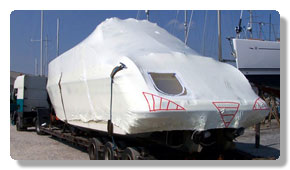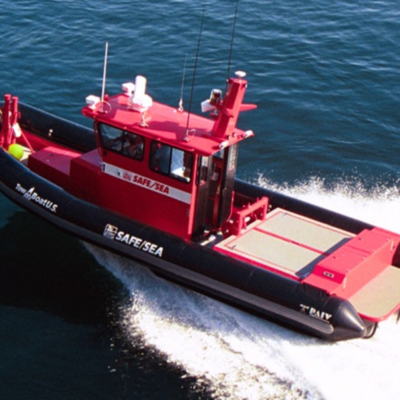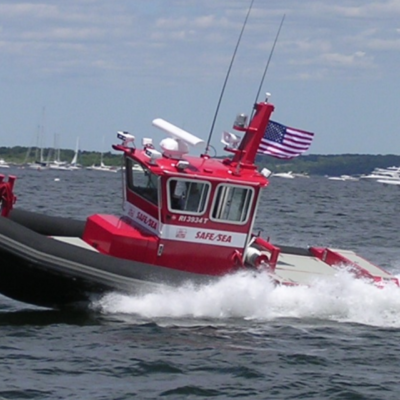Tips For Winterizing Your Boat
Article courtesy of Seaworthy Magazine, from Boat U.S.
After a winter of snow and ice you'd think an early thaw would be welcome relief, but at a marina in Illinois it was bad news for the stored boats. As the frozen ground became soft, several of the jack stands that had been supporting the hulls dug into the mud and toppled over. None of the stands had been resting on plywood and none were chained together.
According to one industry expert, three times as many boat hulls are damaged by mishandling ashore than are damaged by accidents in the water. Some of the boats, like the ones in Illinois, are damaged suddenly when jack stands fail or when they tumble from a travelift or are blown over in windstorms.
Many other boats, however, are damaged slowly because they are stored, year after year, without proper support beneath the hull. When a hull becomes even slightly distorted, it causes problems ranging from poor engine alignment to broken stringers and even impaired performance under way.
And while sudden accidents are covered by insurance, losses that occur slowly are considered to be the result of "wear and tear" and are not insured.
Whenever a boat is hauled out and stored ashore for the winter, it is critical to provide adequate support for the hull. Properly supported, a hull ashore will be just as comfortable as a boat stored in the water for the winter. Boats stored ashore (on high ground) won't sink and are also less likely to develop blisters.
The most reliable support is provided by a custom-made cradle, which is designed specifically to support critical areas of a boat -- its engines, bulkheads, and keel. (Don't store your boat on a cradle that was built for a different model boat.) Steel cradles are best, but wood cradles will also do the job if they have been inspected for deteriorated wood and corroded fastenings. Shipping cradles are probably OK, but most will require some modification to improve lateral support before they can be used for prolonged storage.
Despite the advantages, storing cradles in the off-season is often a problem at many crowded boatyards, which rely instead on a combination of screw-type jack stands and timbers to support hulls. Most boatyards do a competent job of positioning the supports, but it never hurts to discuss technique with the yard manager before the boat is hauled.
You could also take a cue from commercial vessels, which have their own blocking plans indicating where blocks and jack stands should be placed to provide the best support. Manufacturers may be able to supply you with a plan, or you can work with the yard manager to devise one yourself using a diagram of your boat. Save the plan and give a copy to anyone who hauls the boat in the future.
With jack stands, the stand should be perpendicular to the hull so it directs the boat's weight toward the ground. Misalignment of the stand will force it out as the load is applied. Even if the stand is aligned perfectly, safety chains must be used to prevent stands from slipping out from under the hull.
Jack stands should be placed as far out from the boat as practical to support the boat in high winds, with at least three per side for boats over 26' and additional supports at long overhangs. Plywood should be placed under each base to prevent its sinking into mud, sand or asphalt. Even when stands rest on clay that seems brick hard, they can be loosened by heavy spring rains, shift, and spill the boat.
While jack stands must be placed properly to prevent the boat from falling over, most of the boat's weight rests on its keel. Some boats have specific requirements for support of the keel, but at least one manufacturer warns against puting weight on the keel. If the marina manager isn't familiar with your boat, check your manual or contact the manufacturer.
Keels must be supported by wide, thick timbers -- the wider the better to distribute the load. Cinder blocks are prone to breaking and should not be used. On powerboats, additional support is usually recommended for inboard engines, fuel tanks, and heavy machinery. With outboard and outdrive boats, weight should be taken off the transom by lowering the drive units onto a block. After the boat is blocked, sight along the hull and keel to make sure the jack stands aren't depressing the hull. (Check again in two weeks after the boat has settled.) The deck must also be level, or water could pool and cause stains and/or gelcoat crazing.
Never secure the boat's winter cover to the jack stands or support blocks. There are many accounts in the claim files of boats that fell over after stiff winds filled the covers and yanked the supports away. Finally, make sure the cover is supported adequately. Poorly supported covers will accumulate snow and water, which add considerable weight to the boat. Scuppers and drains should also be left open for the same reason -- to channel water from the decks and cockpit.
An increasing number of boats are being stored ashore on dry storage racks. These racks are designed to support "typical" boat hulls, but can't always be adjusted to support unusual or atypical designs. If you have doubts about the support provided by a rack, consult a marine surveyor or consider an alternative winter location such as a trailer, which has adjustable rollers and pads to support critical areas.
The exception is deep-draft sailboats. Trailers are designed to support these boats when the wind is on the bow and are rarely wide enough to provide adequate protection for deep-draft boats (typically, racing sailboats) when strong winds are on the beam. To provide additional lateral support, use extra jack stands along the hull and unstep the mast to reduce windage. Centerboard boats will probably be OK on a trailer, especially if they are secured to the trailer's frame and the mast is unstepped.

-

Premier Membership
$175.00 – $322.00 Select options This product has multiple variants. The options may be chosen on the product page -

Elite Membership
$224.00 – $371.00 Select options This product has multiple variants. The options may be chosen on the product page
